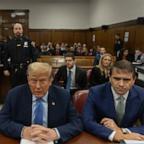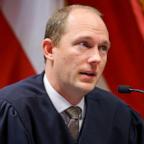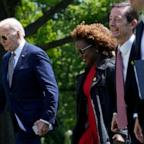Grigor Dimitrov a changed man
— -- LONDON -- Greatness at the junior level does not necessarily translate in the professional ranks.
For every Bjorn Borg, Stefan Edberg and Roger Federer -- Wimbledon junior champions and multiple All England Club professional titlists -- there are the T.C. Reids, Thiemo de Bakkers and Donald Youngs. Federer won the boys' singles here in 1998, and five years later, the first of seven crowns. But of the subsequent 15 junior champions, only two, Jurgen Melzer and Gael Monfils, managed to make themselves into top-10 players.
At the age of 16 or 17, it is impossible to know if an athlete will mature and evolve physically and mentally into a truly elite player. Which brings us to Grigor Dimitrov, who won juniors here six years ago. He still could go either way.
His former coach, Peter Lundgren, observed that the diversely skilled Bulgarian was more advanced at the same age than Federer, whom he also coached, prompting the nickname "Baby Fed." And the horrible burden of impossible expectation was born.
"At first I thought it was just funny," Dimitrov said last week en route to winning the Aegon Championships at Queen's Club. "But it actually became boring. Four years later people are still talking about it.
"I feel like I want to tell them, 'Guys, don't say it.' I think I've proved myself already. I'm not that guy."
No, but these days -- on so many levels -- it might be better to be Grigor Dimitrov. Seriously, all things considered, who would you rather be right now?
On Friday, he showed an abundance of resolve in a stirring 6-7 (3), 6-4, 2-6, 6-4, 6-1 third-round victory over No. 21 Alexandr Dolgopolov. Dimitrov is already two rounds beyond his best effort here.
By most standards, Dimitrov, who turned 23 last month, has put together a nice little career. At No. 13, he is the youngest player in the top 20 and is having the best year of his life, but there is a vague sense that he didn't get there quickly enough. Now he is on the cusp of the greatness that was predicted for him.
The curve accelerated dramatically in October when he beat David Ferrer in the Stockholm final for his first ATP World Tour title -- and hired Roger Rasheed as his coach (whose previous students include Lleyton Hewitt, Jo-Wilfried Tsonga and Monfils). They were signals that he was ready to approach tennis as a serious profession.
"Before, I think he was just a young kid happy to be part of the tennis scene," said Darren Cahill, an ESPN analyst who coached Hewitt as well as Andre Agassi. "The players in the locker room will tell you that he's a different player than he was 12 months ago. He's doing the things he needs to take care of business.
"He's stripped things down and simplified things."
Indeed, when many players surround themselves with entourages -- coaches, hitting partners, trainers, friends and significant others -- Dimitrov is traveling light. Thursday, he sat by himself in the back of a restaurant on High Street in Wimbledon Village, alone with his smoothie and smart phone. He might have been texting his girlfriend of 18 months, Maria Sharapova, but he said when they are playing tennis at the same event, "everyone does his own thing."
Dimitrov, who is listed at 6-foot-3, 176 pounds, is a lovely player. Like Federer, he has a diversity of game that sometimes leaves him with almost too many choices. He has bulked up his first serve, made his movement more efficient and turned his one-handed backhand, sometimes a liability in juniors, into a weapon.
The results have been impressive. He reached the quarterfinals at the Australian Open, his best effort at a Grand Slam, beating Milos Raonic -- the other ascendant 23-year-old -- along the way. Dimitrov has added three titles to his portfolio this year, on the hard courts of Acapulco, the clay in Bucharest and, most recently, the grass at Queen's. He is the only ATP player to win this season on three different surfaces.
More important, he has been consistent; in 15 events, he has crashed out only once in the first round. According to Cahill, he is closing better, too, finding what Rafael Nadal likes to call "solutions."
"Before, he'd get ahead and he was like a windshield wiper," said Cahill, swinging his hand back and forth. "He's playing himself into a winning position, then go away from the formulas and the patterns that got him there. Now, he's consolidating those positions and finishing matches."
A year ago, Dimitrov might have folded in the fourth-set tiebreaker against the big-serving Raonic in Melbourne. In January, he prevailed 12-10. And, after Dolgopolov won the third set Friday, he might have faded. But he didn't, and now his Grand Slam record stands at 14-14.
There is an undeniable style about him; when his first-round match against Ryan Harrison was no longer in doubt, Dimitrov executed a few sparkling between-the-legs shots that pleased the patrons. When he took his shirt off after beating Dolgopolov a faint murmur rippled through the crowd.
If the No. 11 seed beats Leonardo Mayer, as most people anticipate, he is looking at a likely quarterfinal meeting with defending champion Andy Murray.
Wouldn't that be fun?
"Today was one of those matches where the only thing I could ask myself was to be as composed as I could," Dimitrov said of his loss of the first set. "I got back together and then . . . I was too strong."
The last set slipped by in a scant 18 minutes.
"It's all the work I've put in, all the practice," he added. "I was hungry for that match. I really wanted it."




